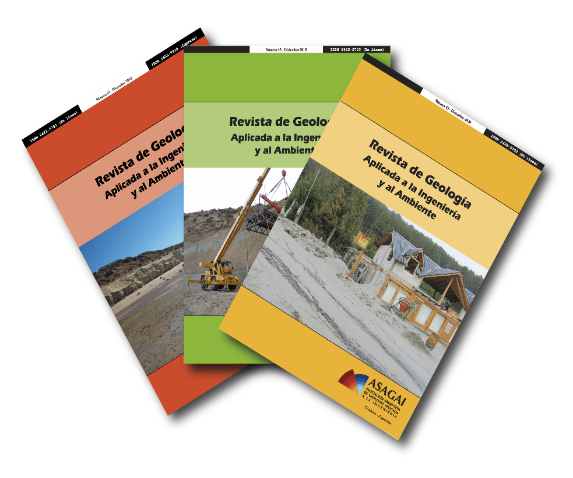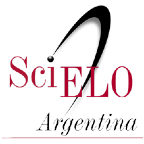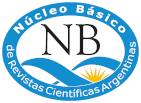Estimation of potential groundwater recharge of an aquifer through remote sensing and geographical information systems
DOI:
https://doi.org/10.59069/24225703ee006Keywords:
Zapala aquifer, remote sensing, hierarchical analysis processAbstract
The arid, semi-arid, and sub-humid zones occupy cover 41% of the land surface. In these areas, water resources are limited and are under severe and increasing pressure due the increase in population, in per capita use, and in irrigation. Groundwater, whether phreatic or confined, it is an essential water resource to supply of other sources or constitute the primary source for water in the area. This study was carried out in the area occupied by the Zapala aquifer, Neuquén province, Argentine Republic. An index was implemented to estimate aquifer potential recharge from remote sensors data and processing in with a Geographic Information System. It was found that 54% of the study area has a moderate recharge potential, 43% has a good potential, and 3% has a leading potential. The estimation of the annual recharge was 74 hm3 /year, 63% of the average annual precipitation. Compared to previous studies carried out by other authors with different methods. The annual recharge obtained are within the range of variation of these studies, so the index is shown as a good approximation for estimating recharge.
References
Arroyo, J. (1980). Relevamiento y priorización de áreas con posibilidades de riego. Provincia del Neuquén. (Vol. II). Consejo Federal de Inversiones.
Avtar, R., Singh, C.K., Shastri, S., Singh, A. y Mukherjee, S. (2010). Identification and analysis of groundwater potential zones in Ken–Betwa river linking area using remote sensing and geographic information system. Geocarto International. 25(5), 379-396. https://doi.org/10.1080/10106041003731318
Barbosa, P. y Weynants, M. (2018). Vulnerabilidad de las tierras secas a la desertificación, degradación de las tierras e impactos económicos y sociales. Oficina de Publicaciones de la Unión Europea.
Bastianelli, N., Garrido, A., Albouy, R. y Carrica, J. (2016). El recurso hídrico subterráneo de la ciudad de Zapala, Neuquén: ambiente geológico de la formación la Bardita. En E. Custodio, M. Varni y R.F. García (Eds.), IX Congreso Argentino de Hidrogeología y VII Seminario Hispano-Latinoamericano Sobre Temas Actuales de la Hidrología Subterránea (Catamarca) (pp. 134-141).
Carrica, J.C, Delpino, D. y Bonorino G. (1997). Aspectos hidrogeológicos de los alrededores de la ciudad de Zapala, provincia del Neuquén. En Actas del I Congreso Nacional de Hidrogeología (Bahía Blanca) (pp. 165-182).
Carson, M.A. y Kirkby, M.J. (1972). Hillslope form and processes (Cambridge Geographical Studies 3). Cambridge University Press, Oxford.
Chow, V.T. (2000). Hidrología aplicada. McGraw-Hill.
Delpino D., Giusiano A. y Deza M. (1994). Mapa geológico del departamento de Zapala. [Inédito]. Dirección Provincial de Minería de la Provincia del Neuquén.
Dufilho, A.C., Toth, A. y Valle, D. (2002). Elaboración de bases para el ordenamiento territorial ambiental de la provincia del Neuquén. CFI-COPADE.
Environmental Systems Research Institute. (2022). Acumulación de flujo (Spatial Analyst). ArcGIS Pro. https://pro.arcgis.com/es/pro-app/latest/tool-reference/spatial-analyst/flow-accumulation.htm
Environmental Systems Research Institute. (2023). World Imagery Tile Layer [Imágenes]. https://server.arcgisonline.com/ArcGIS/rest/services/World_Imagery/MapServer/tile/{z}/{y}/{x}
Gaitán, J.J., López, C.R. y Bran, D.E. (2009). Efectos del pastoreo sobre el suelo y la vegetación en la estepa patagónica. Ciencia del Suelo, 27(2), 261-270.
Gaitán, J.J., López, C., Ayesa, J., Siffredi, G. y Umaña, F. (2009). Reconocimiento, cartografía y evaluación de mallines. Área Zapala, provincia del Neuquén. Centro Regional Patagonia Norte, Área de Investigación en Recursos Naturales, INTA EEA Bariloche.
Gatica, J., Dufilho, A.C. e Irrisari, J. (2018). Estimación de la recarga potencial anual de acuíferos en la provincia de Neuquén. En R. García, E. Castro, M. Auge, C. Falcón y M. Blarasín (Eds.), Hidrogeología Regional. XIV Congreso Latinoamericano de Hidrogeología (Salta). (Vol. I).
Global Learning and Observations to Benefit the Environment. (2005). Investigación de cobertura terrestre/biología. GLOBE
Herrick, J.E., Van Zee, J.W., Havstad, K.M., Burkett, L.M. y Whitford, W.G. (2017). Monitoring manual for grassland, shrubland and savanna ecosystems. (Vol. I). USDA -ARS Jornada Experimental Range.
Instituto Geográfico Nacional. (2020). Argentina y el mundo: Rasgos y componentes del territorio argentino. ANIDA. Atlas Nacional Interactivo de Argentina, Instituto Geográfico Nacional.
Khodaei, K. y Nassery, H.R. (2011). Groundwater exploration using remote sensing and geographic information systems in a semi-arid area (Southwest of Urmieh Northwest of Iran). Arabian Journal of Geoscience, 6(4), 1229–1240. https://doi.org/10.1007/s12517-011-0414-4
Leanza, H.A., Hugo, C.A., Herrero, J.C., Donnari, E. y Pucci, J.C. (1997). Picún Leufú. Programa Nacional de Cartas Geológicas de la República Argentina 1:250.000. Hoja Geológica 3969-III. Provincias de Neuquén y Río Negro. Servicio Geológico Minero Argentino, Instituto de Geología y Recursos Minerales.
Leanza, H.A., Hugo, C., Repol, D., González, R., Danieli, J.C. y Lizuani, A. (2001). Hoja Geológica 3969-I, Zapala. Provincia del Neuquén. Boletín 275. Servicio Geológico Minero Argentino, Instituto de Geología y Recursos Minerales.
Macas-Espinosa, V.X. y López-Escobar, K.F. (2018). Potencial para la exploración de aguas subterráneas en la demarcación hidrográfica Puyango Catamayo, Ecuador, utilizando un proceso de análisis jerárquico basado en SIG y teledetección. Revista de Teledetección, 51,135-145. https://doi.org/10.4995/raet.2018.7592
Martínez de Azagra Paredes, A. y Navarro Hevia, J. (1996). Hidrología forestal: el ciclo hidrológico. Secretariado de Publicaciones, Universidad Valladolid.
Matteucci, S.D. (2012). Ecorregión Estepa Patagónica. En J.H. Morello, S.D. Matteucci, A.F. Rodriguez y M.E. Silva (Eds.), Ecorregiones y complejos ecosistémicos argentinos (pp. 549-654). (1ª ed.). Orientación Gráfica Editora.
Organización de las Naciones Unidas para la Agricultura y la Alimentación FAO (Organización de las Naciones Unidas para la Agricultura y la Alimentación). (2002). LocClim, Estimador Local Mensual Climático.
Pérez Pardo, O., Campomane, J., Cerruti, J., Cobello, H., Corso, M.L., Fernández Beyro, M., Freiler, S., Fruttero, Z., Maccagno, P., Machado, E., Morel, R., Rueda Avellaneda, O., Uccelli, A. y Viegas Auerlio, P. (2005). Manual sobre Desertificación. Dirección de Conservación del Suelo y Lucha contra la Desertificación, Secretaría de Ambiente y Desarrollo Sustentable, Ministerio de Salud y Ambiente de la Nación.
Ramilo, E.J., Chehébar, C.E. y Mazzucchetti, S. (1993). Plan general de manejo Parque Nacional Laguna Blanca. Administración de Parques Nacionales.
Reynolds, J.F., Stafford Smith, D.M., Lambin, E.F., Turner II, B.L., Mortimore, M., Batterbury, S.P.J., Downing, T.E., Dowlatabadi, H., Fernández, R.J., Herrick, J.E., Huber-Sannwald, E., Jiang, H., Leemans, R., Lynam, T., Maestre, F.T., Ayarza, M. y Walker, B. (2007). Global Desertification: Building a Science for Dryland Development. Science, 316, 847-851. https://doi.org/10.1126/science.1131634
Saaty, T. (1980). Multicriteria decision Making: The analytic hierarchy process. McGraw Hill.
Soil Conservation Service. (1972). National engineering handbook. Section 4: Hydrology. U.S. Department of Agriculture.
Smith, B. y Sandwell., D. (2003). Accuracy and resolution of shuttle radar topography mission data. Geophysical Research Letters, 30(9), 20-23. https://doi.org/10.1029/2002GL016643
Tumare, J., Jana, S.K. y Pal, D.K. (2014). Application of remote sensing and GIS for groundwater potential zone investigation in Bulolo-Wau surrounding Gold Mine, Morobe Province, Papua New Guinea. International Journal of Geoinformatics, 10(4), 45-57. https://journals.sfu.ca/ijg/index.php/journal/article/view/579
United States Geological Survey. (s./f.). EarthExplorer. Recuperado el 1 mayo 2016 de https://earthexplorer.usgs.gov/
Wheater, H.S. 2007. Modelling hydrological processes in arid and semi-arid areas: An introduction to the workshop. En H. Wheater, S. Sorooshian y K. Sharma (Eds.), Hydrological Modelling in Arid and Semi-Arid Areas. Cambridge University Press. https://doi.org/10.1017/CBO9780511535734
Yeh, H.F., Lee, C.H., Hsu, C.K. y Chang, P.H. (2009). GIS for the assessment of the groundwater recharge potential zone. Environmental Geology, 58, 185-195. https://doi.org/10.1007/s00254-008-1504-9
Downloads
Published
Issue
Section
License
Copyright (c) 2023 Rafael Adrian Maddio, Ana Cecilia Dufilho, Marcelo Gandini

This work is licensed under a Creative Commons Attribution-NonCommercial-ShareAlike 4.0 International License.
Attribution - Non-Commercial - Share Alike (by-nc-sa): No commercial use of the original work or any derivative works is permitted, distribution of which must be under a license equal to that governing the original work.










